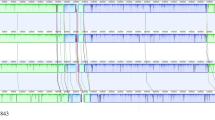Abstract
This study characterises 43Vibrio alginolyticus strains associated with diseased juveniles and older fish ofSparus aurata reared in a marine hatchery installed along the seacoasts of Monastir (Centre of Tunisia).Vibrio alginolyticus strains were isolated using the TCBS modified agar plates and the biochemical activities were tested using the API 20 E strips. The exoenzymes production and antibiotics susceptibility were also investigated. The ERIC-PCR was used to evaluate the genetic diversity of these strains.Vibrio alginolyticus was isolated from seawater (n=16), juveniles with white nodular skin lesions (n=9) and from all the internal organs of the older fish presenting a large and deep lesions in the muscle and with a necrotic eyes (n=18). Most of the studiedV. alginolyticus strains were β-haemolytic, hydrolyze the DNA and produce many exoenzymes such as lecithinase, caseinase, amylase and lipase. All tested strains were resistant to at least three antimicrobial agents. The ERIC-PCR profiles among the isolated bacteria were generally heterogeneous, showing a high polymorphism and suggesting independent circulation with some evidence of cross-transmission.
Similar content being viewed by others
References
Alsina M., Blanch A.R. (1994a). A set key for biochemical identification of environmentalVibrio species. J. Appl. Bacteriol., 76:79–85.
Alsina M., Blanch A.R. (1994b). Improvement and update of a set of key for biochemical identification of key for biochemical identification ofVibrio species. J. Appl. Bacteriol., 77: 719–721.
Ashraf A.K., McCarthy S., Wang R.F., Cerniglia C.E. (2001). Characterization of United States outbreak isolates ofVibrio parahaemolyticus using enteriobacterial repetitive intergenic consensus (ERIC) PCR and development of a rapid PCR method for detection of O3:K6 isolates. FEMS Microbiol. Lett., 206: 209–214.
Austin B., Stobie M., Robertson P.A.W., Glass H.G., Stark J.R. (1993).Vibrio alginolyticus: the cause of gill disease leading to progressive low-level mortalities among juvenile turbot,Scophthalmus maximus L., in a Scottish aquarium. J. Fish Dis., 16: 277–280.
Bakhrouf A., Jeddi M., Ben Ouada H. (1995), Essai de traitement des vibrioses du loupDicentrarchus labrax dans une zone de pisciculture, à Monastir, Tunisie. Marine Life, 5 (2): 47–54.
Balebona M.C., Andrew M.J., Bordas M.A., Moriñigo M.A., Zorilla I., Borrego J.J. (1998). Pathogenicity ofVibrio alginolyticus for cultured gilt-head sea bream (Sparus aurata). App. Environ. Microbiol., 64 (11): 4269–4275.
Ben Kahla-Nakbi A., Chaieb K., Besbes A., Zmantar T., Bakhrouf A. (2006). Virulence and enteriobacterial repetitive intergenic consensus PCR ofVibrio alginolyticus strains isolated from Tunisian cultured gilthead sea bream and sea bass out-breaks. Vet. Microbiol., 117 (2–4): 321–327.
Bordas M.A., Balebona M.C., Zorilla I., Borrego J.J., Moriñigo M.A. (1996). Kinetics of adhesion of selected fish-pathogenicVibrio strains to skin mucus of gilt-head sea bream. Appl. Environm. Microbiol., 62: 3650–3654.
Cavallo J.D., Chardon H., Chidiac C., Choutet P., Courvalin P., Dabernat H., Drugeon H., Dubreuil, L., Goldstein F., Jarlier V., Leclerq R., Nicolas-Chanoine M.H., Philippon A., Quentin C., Rouveix B., Sirot J., Soussy C.-J. (2006). Communiqué. CSFA—Comité de l’antibiogramme de la société Française de Microbiologie.
Chaieb K., Abbassi M.S., Touati A., Hassen A.B., Mahdouani K., Bakhrouf A. (2005), Molecular characterization ofStaphyloccocus epidermidis isolated from biomaterials in a dialysis service. Ann. Microbiol., 55: 309–314.
Colorni A., Paperna I., Gordin H. (1981). Bacterial infections in gilt-head sea breamSparus aurata cultured at Elat. Aquaculture, 23: 257–267.
Croci L., Serratore P., Cozzi L., Stacchini A., Milandri S., Suffredini E., Toti L. (2001). Detection ofVibrionaceae in mussels and in their seawater growing area. Lett. Appl. Microbiol., 32: 57–61.
Di-Pinto A., Ciccarese G., Fontanarosa M., Terio V., Tantillo G. (2006). Detection ofVibrio alginolyticus andVibrio parahaemolyticus in shellfish using collagenase-targeted multiplex-PCR. J. Food Safety, 26: 150–159.
Divanch P., Kentouri M. (1983). Influences des conditions trophiques initiales sur la résorption des réserves lipidiques, la croissance et la survie des larves de daurades,Sparus aurata, en élevage extensif. Aquaculture, 35: 43–55.
Elliot E.L., Kaysner C.A., Tamplin M.L. (1992).V. Cholerae, V. parahaemolyticus, V. vulnificus and otherVibrio spp., In: Bacteriological Analytic Mannual, Food and Drug Administration, Arlington, AOAC International, pp. 111–140.
Elliot E.L., Kaysner C.A., Jackson L., Tamplin M.L. (1995).Vibrio cholerae, V parahaemolyticus, V. vulnificus and otherVibrio spp. In: FDA Bacteriological Analytical Manual, 8th edn., AOAC International, Gaithersburg, MD, pp. 9.01–9.27.
Fabiano L.T., Iida T., Swings J. (2004). Biodiversity of Vibrios. Microbiol. Mol. Biol. Rev., 68 (3): 403–431.
Finkelstein R., Edelstein S., Mahamid G. (2002). Fulminant wound infections due toVibrio vulnificus. Israel Med. Assoc. J., 4: 654–655.
Gahrn-Hansen B., Hornstrup M.K. (1994). Extraintestinal infections caused byVibrio parahaemolyticus andVibrio alginolyticus at the country of Funen 1987–1992. Ugeskr. Laeger., 156: 5279–5282.
Gomez J.M., Fajardo R., Patiño J.F., Arias C.A. (2003). Necrotizing fasciitis due toVibrio alginolyticus in an immuno-competent patient. J. Clin. Microbiol., 41 (7): 3427–3429.
Hörmansdorfer S., Wentges H., Neugebaur-Büchler K., Bauer J. (2000). Isolation ofVibrio alginolyticus from seawater aquaria. Int. J. Hyg. Environ. Health, 203: 169–175.
López-Torres M.A., Lizárraga-Partida M.L. (2001). Bacteria isolated on TCBS media associated with hatched Artemia cysts of commercial brands. Aquaculture, 194: 11–20.
Marshall F.J., Clarck C.G., Wang G., Mulvery M., Kelly M.T., Johnson W.M. (1999). Comparaison of molecular methods for typingVibrio parahaemolyticus. J. Clin. Microbiol., 37: 2473–2478.
NCCLS—National Committee for Clinical Laboratory Standards (2002). Performance standards for antimicrobial disk and dilution susceptibility tests for bacteria isolated from animals. Tentative standards. M31-T. Document M31-T, Wayne.
O’Hara C.M., Sowers E.G., Bopp C.A., Duda S.B., Strockbine N.A. (2003). Accuracy of six commercially available systems for identification of members of the familyVibrionaceae. J. Clin. Microbiol., 41: 5654–5659.
Ottaviani D., Bacchiocchi I., Masini L., Leoni F., Carraturo A., Giammarioli M., Sbaraglia G. (2001). Antimicrobial susceptibility of potentially pathogenic halophilic vibrios isolated from seafood. Int. J. Antimicrob. Ag., 18: 135–140.
Ottaviani D., Masini L., Bacchiocchi S. (2003). A biochemical protocol for the isolation and identification of current species ofVibrio in seafood. J. Appl. Microbiol., 95: 1277–1284.
Overman T.L., Kessler J.F., Seabolt J.P. (1985). Comparison of API 20E, API Rapid E and API Rapid NFT for identification of members of the familyVibrionaceae. J. Clin. Microbiol., 22: 778–781.
Paperna I. (1984). Review of diseases affecting culturedSparus aurata andDicentrarchus labrax, In: Barnabé G., Billard R., (edEds), L’Aquaculture du Bar et des Sparidés. INRA Publisher, Paris, France, pp. 465–482.
Reina J., Fernandez-Baca V., Lopez A. (1995). Acute gastroenteritis caused byVibrio alginolyticus in an immu-nocompetent patient. Clin. Infect. Dis., 21: 1044–1045.
Ripabelli G., Sammarco M.L., McLauchlin J., Fanelli I. (2003). Molecular characterisation and antimicrobial resistance ofVibrio vulnificus andVibrio alginolyticus isolated from mussels (Mytilus galloprovincialis). Syst. Appl. Microbiol., 26 (1):119–126.
Rudolph K.M., Parkinson A.J., Roberts M.C. (1998). Molecular analysis by pulsed-field gel electrophoresis and antibiogram ofStreptococcus pneumoniae serotype 6B isolated from selected areas within the United States. J. Clin. Microbiol., 36: 2703–2707.
Sambrook J., Fritsch E.F., Maniatis T. (1989). Molecular Cloning: A Laboratory Manual, 2nd edn., Cold Spring Harbor Laboratory Press, Cold Spring Harbor, N.Y.
Snoussi M., Chaieb K., Rouabhia M., Bakhrouf A. (2006). Quantitative study, identification and antibiotics sensitivity of someVibrionaceae associated to a marine fish hatchery. Ann. Microbiol., 56 (4): 289–293.
Tülay A., Gülsen T. (2002). Vibriosis in Gilthead Sea Bream (Sparus aurata L.) in farms in the Aegean Sea Coast of Turkey. Turkish Journal of Fisheries and Aquatic Sciences, 2: 89–91.
Wachsmuth I.K., Blake P.A., Olsvik O. (1994).Vibrio cholerae and cholera. Molecular to global perspectives. ASM Press, Washington, D.C.
Zanetti S., Deriu A., Volterra L., Falchi M.P., Molicotti P., Fadda G., Sechi L. (2000). Virulence factors inVibrio alginolyticus strains isolated from aquatic environments. Ann. Ig., 12 (6): 487–491.
Zanetti S., Spanu T., Deriu A., Romano L., Sechi L.A., Fadda G. (2001).In vitro susceptibility ofVibrio spp. isolated from the environment. Int. J. Antimicrob. Ag., 17: 407–409.
Zorilla I., Moriñigo M.A., Castro D., Balebona M.C., Borrego J.J. (2003). Intraspecific characterization ofVibrio alginolyticus isolates recovered from cultured fish in Spain. J. Appl. Microbiol., 95: 1106–1116.
Author information
Authors and Affiliations
Corresponding author
Rights and permissions
About this article
Cite this article
Snoussi, M., Hajlaoui, H., Noumi, E. et al. Phenotypic and genetic diversity ofVibrio alginolyticus strains recovered from juveniles and olderSparus aurata reared in a Tunisian marine farm. Ann. Microbiol. 58, 141–146 (2008). https://doi.org/10.1007/BF03179458
Received:
Accepted:
Issue Date:
DOI: https://doi.org/10.1007/BF03179458




